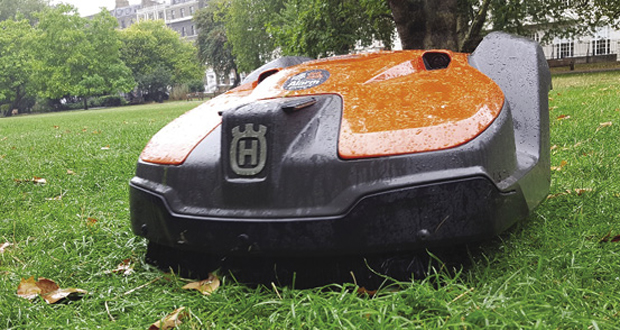 As technology advances, will we see mother nature’s green spaces and beloved landscapes controlled by the click of an App? Angus Lindsay from idverde, looks at what is possible now, what is feasible, where the future is really heading and what is merely science fiction
As technology advances, will we see mother nature’s green spaces and beloved landscapes controlled by the click of an App? Angus Lindsay from idverde, looks at what is possible now, what is feasible, where the future is really heading and what is merely science fiction
You don’t jump to the moon in a single leap. From when the space race started to when we landed on our lunar partner, millions of tiny iterative steps were taken. The same is true, obviously on a far smaller scale, when we consider the future of grounds maintenance. From where we are now to a brave new world of drones and automation requires small steps, progression, failing, learning and a healthy dose of realism.
From drones to robotic mowers, VR to AI watering sensors, the image of traditional horticultural – one of pruning, preening, cutting all steered by a human hand – could be about to change. But what is that brave new world? What does it look like?
TECHNOLOGY FOR THE NOW AND FOR THE FUTURE
For me, it is one that we, as caretakers for the planet, are responsible and proactive in our attention to our legacy. It is a future of carbon-neutral technologically enabled automation. It is of artificially intelligent ‘ecosystems’ working hand-in-hand with humans to detect and then act upon changes in the environment. It is one where we have ground maintenance based on need rather than frequency and rotas.
The technology to take this leap forward is, in many cases, already here, it is just not widely adopted. GPS mapping, drone site inspections, robotic tractors, laser cutting, alternative weed control and AI that offers preventative actions based on footfall and actual requirements – can all be utilised (at a cost, of course). At idverde, we have been using, with great success, robotic mowers in closed London parks for some time. Quietly, efficiently getting about their work as residents sleep.
How quickly will these technologies become commonplace? It is worth reminding ourselves that change normally comes in small doses (did you know that the first driverless tractor was developed in the 1960s and the first radio-controlled mower was built in 1959?). Take your day-to-day power tools. From twenty years ago to today, we have overcome our cordless technology scepticism to almost complete adoption. That change did not come with a fanfare, it happened slowly and naturally.
I suspect we will see similar changes with the use of drones. Drones are far from gimmicky and are here to stay. Will we ever see them armed with blades descending on a park to cut and prune? Not for a while (imagine the insurance for that!), but what we can (and what we are doing) is using them to give an overview of our parks – giving judgement on what routes to take, where to cut, essentially giving us an eye in the sky that would have been impossible ten years ago.
I see similar changes in how we adapt our vehicles to the necessary emission changes and low emission zones. As a land-based industry, so much of our impact on local and global environments is entwined with the power of our equipment. Manufacturers are making great progress here – Stihl, Husqvarna, Pellenc, and Bosch are all bringing new zero-emission power technology to life. Change and adoption, though, is also often slow. Currently, the cost of a tradition diesel sit-on mower is around £16-18k, while an electric version can be as much as £60k. Economics often dictates that the pace of change may be slower than we desire.
THE HUMAN TOUCH
The advantages of adopting new technologies are clear to me. Climate impacts will be reduced, efficiency improved as we focus our resources on areas that most need it (reducing unnecessary recutting of grass, to over-seeding, to fertiliser spray), meaning better outcomes with less time and money invested. With the right technology and tools, two men could easily do the work of six.
However, with so much power at our fingertips, we must not sacrifice individual passion and expertise – it is all too easy to become a jack of all trades and master of none. Technological developments and manufacturing innovation are still a poor substitute for interpersonal cooperation and really cannot replace informed local knowledge – or what you could describe as the human touch.
Expertise borne from passion is something that no machine can replicate. The small touches that make all the difference cannot be programmed without a true understanding of aesthetics and human desire. These are things we must protect as we integrate new technologies.
Our industry is heavily reliant on people and practical skills, but we are susceptible to a slowly eroding skill base in a sector which may not be people’s career choices. Evolving technology certainly creates different priorities for employers, with different skill sets required, new training regimes are needed but it also potentially offers more exciting opportunities for younger minds.
These considerations might seem mundane when considering the alluring power of change but if you fail to make things easy for people you will fail. Blue sky thinking with great products but without the necessary support around them, will also quickly fail. A solar-powered hovering laser cutting mower is great, but in practical terms, this innovation needs a readily available supply of parts and the knowledge to repair breakdowns (a puncture repair kit alone won’t do).
I am excited by the possibilities of technology, and when managed correctly, we can create a ground maintenance regime based on need rather than frequency. We can use technology to evolve green amenities into ecosystems central to our urban environments. As technology continues to advance there will become more possibilities for innovation and efficiency. We shouldn’t be afraid of change; but we should learn from the past, both good and bad, and not reach a point where we are totally reliant or dependent on technology – we will always need the expert human touch. The fact remains there is no substitute for interpersonal cooperation and experience.





